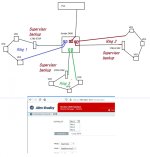Hello, first time poster.
I've been tasked with designing an industrial Ethernet network with about 200 nodes. I'm struggling with setting up a proper topography for the network as I'm not familiar with managed switches and the nodes need to be in DLR. Each node is either a VFD mounted directly to a motor or an armor block handling local IO.
The design I'd like to implement breaks the nodes into 13 groups, these groups make sense given the layout. Then I'll design a local control box with a 1783-ETAP set to ring manager, that will solve local DLR. Then bring all 13 ETAP connections back to a main PLC cabinet and plug them into a Stratix 5400 20 port managed switch.
So my idea is a sort hybrid DLR / Star configuration. My issue is most designs i see in Rockwell documentation don't show anything like this. Topography is shown as ether a star configuration or DLR, not both at once. Because of this, I'm hesitant to move forward with this idea and instead do multiple 5400's as they can handle 5 DLR rings.
I've been tasked with designing an industrial Ethernet network with about 200 nodes. I'm struggling with setting up a proper topography for the network as I'm not familiar with managed switches and the nodes need to be in DLR. Each node is either a VFD mounted directly to a motor or an armor block handling local IO.
The design I'd like to implement breaks the nodes into 13 groups, these groups make sense given the layout. Then I'll design a local control box with a 1783-ETAP set to ring manager, that will solve local DLR. Then bring all 13 ETAP connections back to a main PLC cabinet and plug them into a Stratix 5400 20 port managed switch.
So my idea is a sort hybrid DLR / Star configuration. My issue is most designs i see in Rockwell documentation don't show anything like this. Topography is shown as ether a star configuration or DLR, not both at once. Because of this, I'm hesitant to move forward with this idea and instead do multiple 5400's as they can handle 5 DLR rings.






